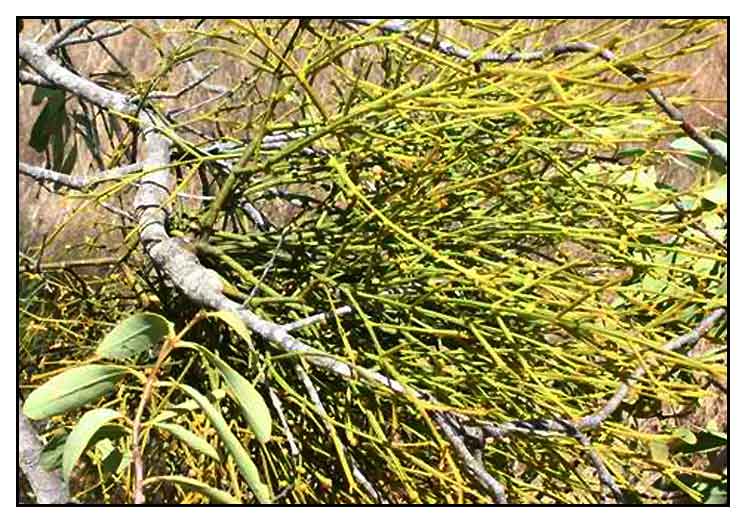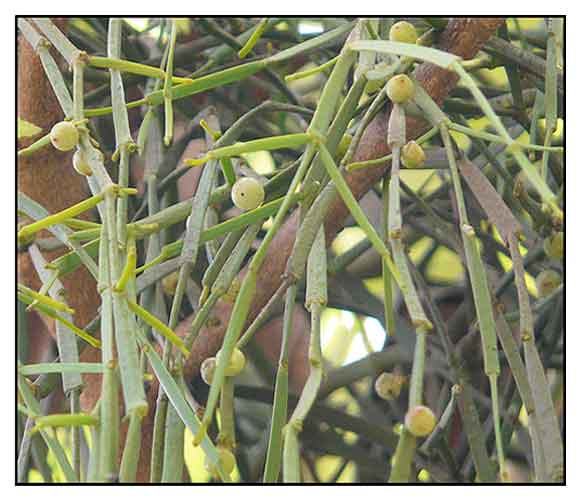 Gen info Gen info
- Viscum is a genus of about 70-100 species of mistletoes. The genus was once placed in its own family, Viscaceae, but recent genetic research by the Angiosperm Phylogeny Group has correctly placed the family within a larger circumscription of the sandalwood family, Santalaceae. (26)
- Etymology: The genus name derives from Latin viscum (English, viscous), referring to the sticky bird lime made from the plant's berries.
 Botany Botany
Taka is a much-branched, slender, smooth, pale, leafless hemi-parasitic plant, forming a green undershrub. Branches are flat, with pendulous tufts, 15 to 90 centimeters long; the internodes being variable in length; usually a trifle wider at the distal end, and striate. Leaves are visible only in the very young internodes as small bracts below the flowers. Flowers are very minute, stalkless, and in stalkless 3-flowered spikes. Spikes are two or several at a joint. Perianth of the male flowers is reflexed, and hardly 1/4 millimeter long. Female flowers are about 1/2 millimeter long, with two bracts, and the perianth lobes erect and triangular. Fruit is stalkless, nearly spherical, about 3 millimeters in diameter, white and shining when ripe.
Distribution
- Native to the Philippines.
-
From northern Luzon to Mindanao, on trees at low and medium altitudes, ascending to 1,200 meters in some regions.
- Also native to Assam, Australia, Bangladesh, Borneo, Cambodia, China, Fiji, Hainan, India, Jawa, Laos, Malaya, Maluku, Myanmar, Nepal, New Guinea, New South Wales, Northern Territory, Queensland, Society Is., Sri Lanka, Sulawesi, Sumatera, Thailand, Tuamotu, Vietnam. (11)
- A hemiparasitic epiphyte that grows primarily in the wet tropical biome. (11)
Constituents
- Leaves yield a tannic acid and resins, soluble in ether and alcohol, producing a blood-red color with strong sulfuric acid.
- Stems yield protein, 0.560 g/100 g dry weight; reducing sugar, 0.0225 g/100 g dry weight, phenols, 0.598 g/100 g, alkaloids, 5.8% per g/100g dry weight.
- Stems yield saponins, anthraquinones, proteins, reducing sugar, alkaloids, glycosides.
- Phytochemical screening yielded polyphenolics and triterpenoids, such as oleanolic acid and lupeol.
- Microscopical examination of powdered whole plant revealed the presence of lignified fibers, vascular bundle, starch grains, epidermis, and parenchyma. Qualitative chemical tests yielded triterpenoids, flavonoids, steroids, saponins, and glycosides.
- Studies have yielded triterpenes (betuline, oleanolic acid, lupeol stearate, lupeol palmitate, lupeol acetate, α-amyrin, lupeol betulinic acid), steroids (ß-sitosterol), flavonoids, phenolic glycosides, tannic acid, ceryl oleonolate, mesoinositol.
- RP-HPLC study of methanolic extract of aerial parts for oleanolic acid showed retention time of 21.5 ± 0.05 min, linearity of response 10-800 µg/mL. LOD and LOQ for oleanolic acid (1.96% w/w) was found to be 0.197 ± 0.63 and 0.623 ± 0.87 µg/mL, respectively.
Properties
- Febrifuge, tonic, sedative, vulnerary.
- Studies have suggested antioxidant, anticancer, antifungal, antihypertensive, antiulcer, antiepileptic, diuretic, anti-inflammatory, immunomodulatory, nephroprotective, antidiabetic, antiproliferative, apoptotic properties.
Uses
Folkloric
- Plant given in cases of fever with aching limbs.
- Poultice of plant applied to cuts.
- In Meghalaya, India, whole plant along with roots of Smilax ferox is boiled in water until the color becomes like red tea, then cooled. The concoction, called Dawai Niangsophet, is then placed in 500 cc bottles; to each bottle, 2 to 3 pieces of Zingiber zerumbet (luiang-usiu) is added and given to newborns, and also, applied over the stomach to prevent stomach troubles. Juice given to lactating and expectant mothers to avoid stomach troubles. Bark of the roots is used to stop dysentery. (6)
- In Chotanagpur, plant preparation used for fever accompanied by aching limbs. Plant bark mixed with egg and Pinus roxburghii leaf is applied as poultice to bone dislocations.
- In
Andhra Pradesh, paste of whole plant with tumeric applied to wounds and boils. Stems used for treatment of insect stings, fever, snake bites. In Odisha, leaves used for hypertension. In Meghalaya, whole plant preparations given for stomach problems in newborn, lactating mothers, to cure snake bites and wounds. In Guharat, whole plant preparations used for muscular pain, dysentery, jaundice. In Uttarakhand, whole plant and seeds used for sterility and hemorrhoids. (21)
-
Also used in atrophy, cachexia, rheumatism, snake bite, bone fracture, joint pains, skin diseases and as abortifacient.
- In Ayurveda, used in Kapha, Vata diseases of the blood, ulcer, epilepsy, biliousness.
- In Chinese medicine, used for treatment of hemorrhage, pleurisy, gout, heart disease, hypertension, epilepsy and arthritis.
- In Cambodia, decoction drunk for bronchitis. In India, used as aphrodisiac and febrifuge, and to treat skin tumors. Poultice of crushed stems applied to cuts. In Taiwan, whole plant used as remedy for neuralgia. In China, whole plants used to treat arthritis. (20)
Studies
• Phytochemicals / Phenolic Glycosides: Study of dried whole plant of Viscum articulatum yielded two new phenolic glycosides, 1-O-benzyl-[5-O-benzoyl-β-D-apiofuranosyl (1→2)]-β-D-glucopyranoside (1), and 4′-hydroxy-7,3′-dimethoxyflavan-5-O-β-D-glucopyranoside, together with nine known flavanones. Compound 9 showed weak anti-HIV-1 activity. (2)
• Flavanone Glycosides / Antioxidant: Study yielded seven new compounds including 3 flavanone glycosides, visartisides A-C, three glycoside acyl esters, visartisides D-F, and one diphenylpropane glycoside along with four known flavanone glycosides. Six compounds exhibited antioxidant activity in either a DPPH or lipopolysaccharide-induced nitric oxide assay. (3)
• Anticancer: A preliminary study on the anticancer activity of an ethanolic extract of Viscum articulatum using a Brine Shrimp Lethality Assay showed very potent cytotoxic activity. Study also showed the hemiparasite exhibited different cytotoxicity on the different hosts suggesting a possible variable transfer of metabolites from the host plants. (4)
• Antifungal Activity: Plant exhibits antifungal activity attributed to the tannic acids and resins.
• Oleanolic Acid / Antihypertensive Activity: Study evaluated the antihypertensive activity of oleanolic acid isolated from V. articulatum in glucocorticoid-induced hypertension in rats. Study showed oleanolic acid significantly prevented the rise in systolic blood pressure and cardiac lipid peroxidation level after administration of dexamethasone. Results suggest oleanolic acid prevents dexamethasone-induced hypertension in rats possibly through its antioxidant and nitric oxide releasing action. (7)
• Diuretic Activity: Study of a methanol extract of V. articulatum demonstrated significant and dose-dependent furosemide pattern of diuretic activity in rats. (8)
• Nephroprotective Activity: Study showed oleanolic acid, isolated from the cuticular epithelium of V. articulatum, exerted a nephroprotective effect on gentamicin-induced renal damage in rats. (9)
• Antihypertensive Effect: Study evaluated the antihypertensive effect of a methanolic extract of V. articulatum against N(w)-nitro-L-arginine methyl ester (L-NAME) induced hypertension in rats. Results showed a hypertensive effect in the NO-deficient type of hypertension, possibly due to its diuretic, nephroprotective and hypolipidemic actions. (13)
• Antioxidant: Study evaluated the antioxidant activity of a methanolic extract of V. articulatum using various assays. Results showed V. articulatum to be a source of antioxidants, with a potential to prevent many free radical related diseases. (14)
• Antiulcer Activity: Study of a methanolic extract showed significant reduction of gastric volume, free acidity and ulcer index. Results showed an anti-ulcerogenic as well as ulcer healing properties, probably due to its anti-secretory activity. (15)
• Antiepileptic / Aerial Parts: Study evaluated a methanolic extract of aerial parts for anti-epileptic activity in rats. Results showed significant antiepileptic activity (p<0.001) attributed to various phytochemical contents. (16)
• Hematologic Biologic Effects / Immunomodulatory Potential: Study cloned a lectin-like B-chain encoding fragment of a type-2 RIP gene, articulatin gene, from V. articulatum, into a bacterial expression vector to obtain a nonglycosylated recombinant protein. The rATB actively bound leukocytes with preferential binding to monocytes and in vitro stimulated PBMCs to release cytokines without obvious cytotoxicity. Results implicated the B-chain fragment as a potential immunomodulator. (17)
• Cytotoxicity: Study evaluated an ethanolic extract for preliminary anticancer activity using Brine Shrimp Lethality Assay. Results showed very potent cytotoxic activity towards this assay, suggesting the preliminary anticancer potential of the plant material. (18)
• Anti-Inflammatory: Study of Viscum articulatum showed anti-inflammatory potential using human red blood cells membrane stabilization method with 68% inhibition of hemolysis, compared to standard drug indomethacin at 72.8%. Results suggest potential for a drug against inflammation. (22)
• Antidiabetic / Whole Plant: Study evaluated the in vitro antidiabetic activity of whole plant of Viscum articulatum. Preliminary phytochemical analysis yielded flavonnoids, steroids, alkaloids, terpenoids. The ethanolic extract of V. articulatum showed anti-diabetic activity by alpha amylase inhibition method and maximum percentage inhibition at 100 µg/ml (83.42%). (24)
• Antiproliferative / Apoptotic / Leukemia Cells / Whole Plant: Study evaluated the antiproliferative and apoptotic effect of aqueous extract of whole plant (VAQE) on Jurkat E6.1 and THP1 leukemia cells. VAQE exhibited high efficacy in exerting cytotoxic effect in Jurkat E6.1 and THP1 CELLS and induction of apoptosis in both leukemia cell lines via disruption of MMP, intracellular ROS imbalance, increased ratio of Bax/Bcl-2, activation of caspase-8, caspase-3, and ROS-mediated DNA fragmentation. (25)
Availability
Wild-crafted.
|

![]()





